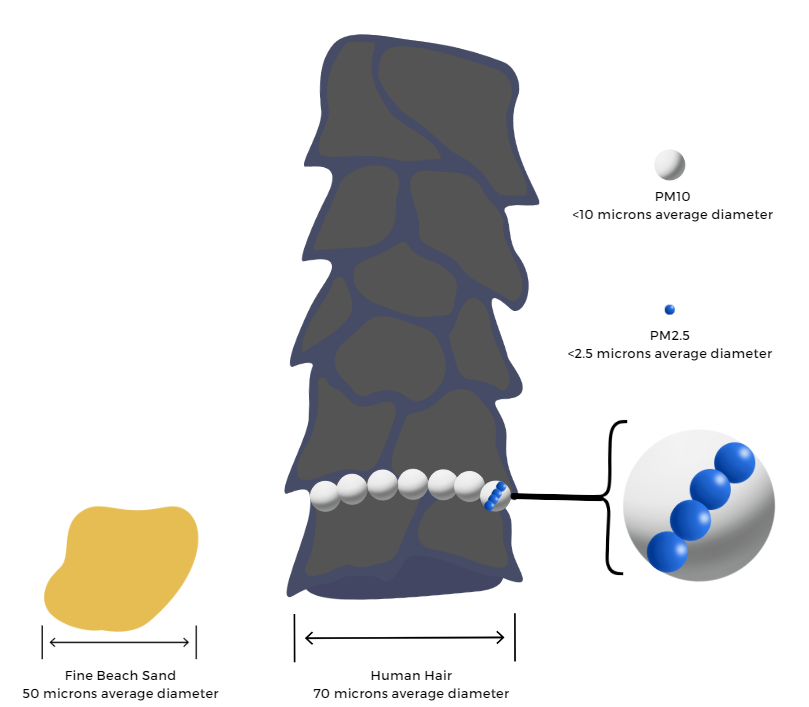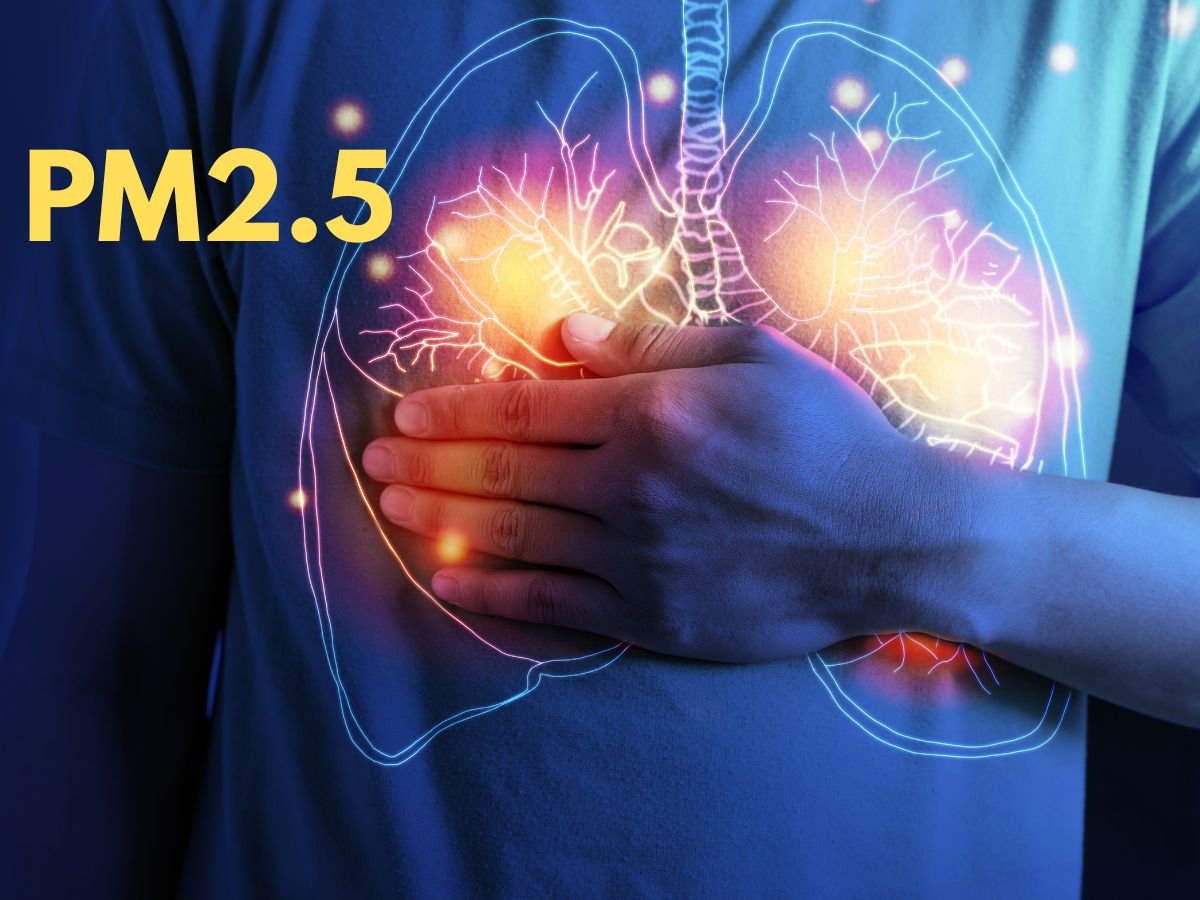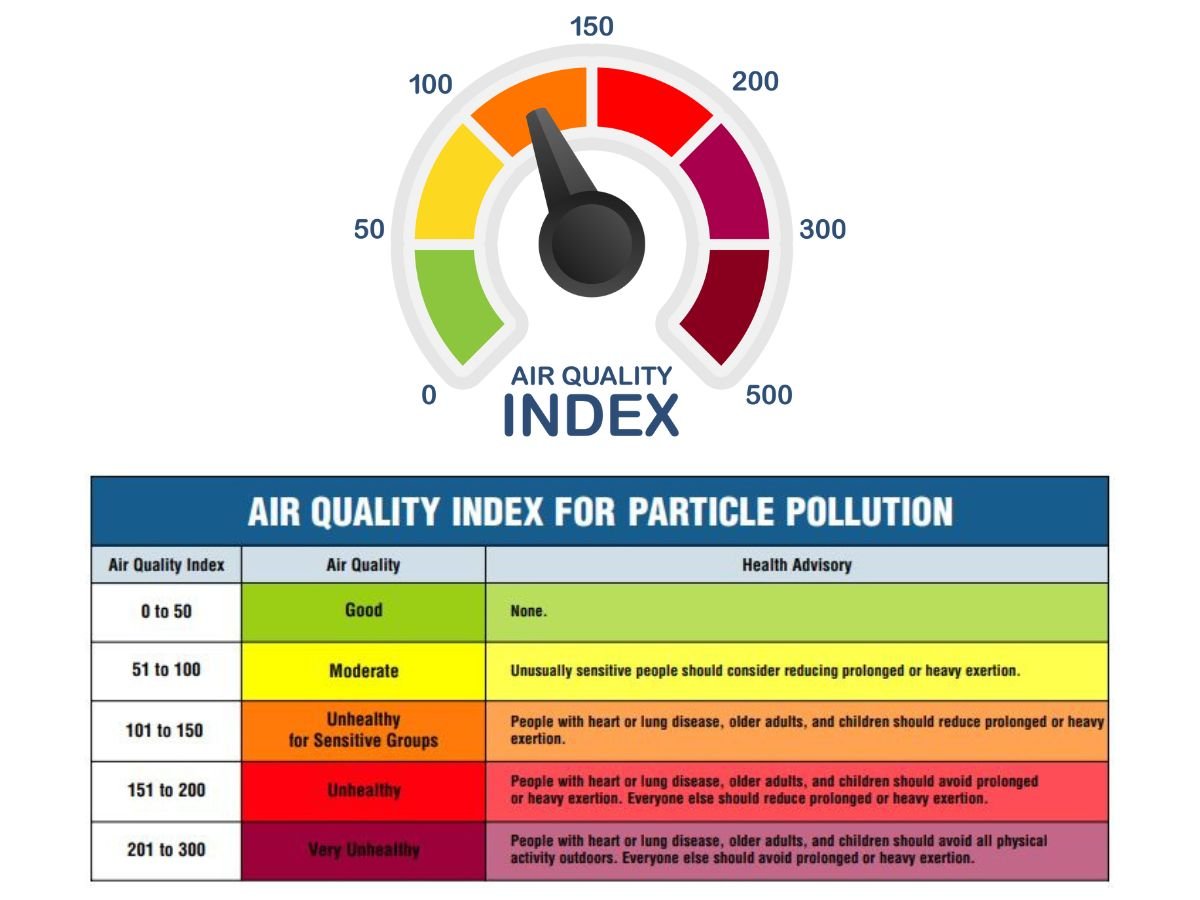What is PM2.5 and How Does it Affect Health?
Have you heard of PM2.5? Whether heard in news coverage of wildfires or air pollution events, or in a science or health article discussing indoor air quality (IAQ), PM2.5 is dangerous for humans and has serious health effects. What is PM2.5 though, and what are the health consequences? Most importantly, how can we reduce our exposure to PM2.5?
What is PM2.5?
PM2.5 is the term used to describe the air pollutant category that has particulate matter, or “PM,” the size of 2.5 microns or smaller. Like an inch, a micron is a unit of measurement for distance, only much, much smaller. How small are these particles though?
To give perspective of the size of PM2.5 particles, the average cross-section of a human hair is 50-70 microns in diameter, while beach sand is 90 microns in diameter. Dust, pollen, and mold, on the other hand, all fall into the category of PM10, or particulates that are 10 microns or less. PM10 is another particulate matter category that is also inhalable into the lungs. PM2.5, or fine particulate matter, technically comprises a portion of PM10 particles.
PM2.5 are very complex particles because these particles can be made up of a variety of chemicals and particle types. They are not a single pollutant, but rather a combination of different ones. Additionally, they can be a combination of solids and aerosols made up of tiny droplets of liquid, solid fragments.
Various sources of PM2.5 can all affect human health negatively.
Where Does PM2.5 Come From?
PM2.5, and other airborne particles, are the main ingredient of smoke, haze, and airborne dust. Some examples of outdoor events that increase the levels of PM2.5 in the air include wildfires, dust storms, industrial pollution from factories, as well as exhaust from automobiles and other modes of transportation to name just a few. Indoors, PM2.5 can be released via cooking, smoking tobacco, burning candles, and the usage of fireplaces.
How can PM2.5 Pollution Affect My Health?
Because particles in the PM2.5 size range are so small, they can travel deeply into our respiratory tract, all the way into the lungs, and even into the bloodstream. The lungs are an intricate organ, with the alveoli, or the air sacs, being made up of a delicate, single-celled membrane. Although PM10 can make it to the lungs and are still dangerous, these particles do not make it into the bloodstream. Particles larger than PM10 can be inhaled, but are caught by the body’s defenses, including nostril hairs and by the mucus lining the respiratory pathway.
Exposure to PM2.5 can affect not only the respiratory tract, but also the heart. PM2.5 pollution has been linked to a variety of health issues including:
Premature death, especially for those with heart or lung disease
Nonfatal heart attacks
Heart arrhythmia, or pulse
More serious asthma
Decline in lung function
Increase in respiratory symptoms, including coughing and shortness of breath
People who already suffer from complications from heart or lung disease are more likely to be affected by PM2.5 pollution. Children are also more at risk because their lungs are still developing, have higher activity levels which leads to more inhalation, and children are more likely to have asthma and other respiratory diseases, of which symptoms are intensified upon exposure to high PM2.5 levels. Older adults are also more at risk, most likely because they have undiagnosed heart or lung issues. Many studies have shown that a high particle level is linked to higher hospitalization rates in older adults as well as an increase in the numbers of deaths due to heart and lung disease complications exacerbated by the exposure.
How to Stay Safe from PM2.5
Checking the AQI in your area can be essential in minimizing PM2.5 inhalation.
PM2.5 can quickly become elevated indoors, especially when outdoor levels are high. The good news is that there are ways to monitor and be aware of when there are high levels of PM2.5 particles outside. Most weather apps include the current reading of the Air Quality Index (AQI) in your specified area. An index number of 0 to 50 has no health advisory, and as the index moves upward, there are more health warnings. Reducing time outside when AQI is at a dangerous level can help you to avoid some exposure. Wearing a high-quality surgical or N95 mask while in areas with high outdoor levels of PM 2.5 can also help protect you so long as the mask is properly fitted and rated to filter out PM 2.5. Keep windows and doors closed at your residence and keep the air conditioning running. However, air from the outside is bound to enter your residence, while indoor activities are still likely to also increase your indoor exposure. So what can help actually reduce PM 2.5 exposure inside?
HEPA Air Purifiers Help Reduce PM2.5 Levels
One of the best scientifically-supported ways to reduce the PM2.5 levels indoors is by investing in a HEPA air purifier (Chen et al., 2022).
A HEPA filter is made up of multiple layers so as to maximize particle entrapment.
Utilizing a HEPA filter, these purifiers are perfectly designed to capture particulate matter from the air, including PM2.5. HEPA filters are composed of multiple layers of media, which trap particles of different sizes, including PM2.5. Air particulates are trapped by the HEPA filter, preventing them from returning to the airstream, and being inhaled into our lungs.
Other small acts that can help keep PM2.5 from entering the airstream indoors include using proper ventilation when cooking and using the oven, avoiding burning candles or wood indoors, and limiting the use of fans, which stir up dust. However, all of these are not enough to actually significantly cut down on PM2.5 alone. Instead, they would be most effective as supplementation to a HEPA air purifying system.
Why ISO-Aire HEPA Air Purifiers
Of the air purifiers available on the market, ISO-Aire takes clean air technology to the next level, being equipped with a 99.99% effective HEPA filter that lasts for 5-6 years, as well as two additional levels of protection with ozone-free bipolar ionization and germicidal UVC.
Not all HEPA air purifiers are equal in their effectiveness, noise levels, lifetime cost, and maintenance requirements. Our team of ventilation and air flow experts have designed ISO-Aire models to pull contaminated air down away from the breathing zone, while distributing and “throwing” clean air high, thereby providing an effective flow of clean air. With a lifespan of over 20 years, ISO-Aire provides great ROI. Implemented at schools and businesses nationwide, ISO-Aire offers near-endless advantages. ISO-Aire saves time and labor cost by being low-maintenance, which cuts down on lifetime cost compared to other air purifier models. Portable, whisper-quiet, and energy-efficient, ISO-Aire purifiers offer the ultimate protection against PM 2.5, viruses, bacteria, mold, pollen, pet dander, and so much more with 99.99% effectiveness or BETTER.
With up to 2000 CFM capacity, our air purifiers are suited for any application, whether it be residential, schools, universities, businesses, daycares, restaurants, hospitals, and much more.
Interested in learning more? Contact our team of air quality specialists at 651-265-0605 or email us at info@iso-aire.com







